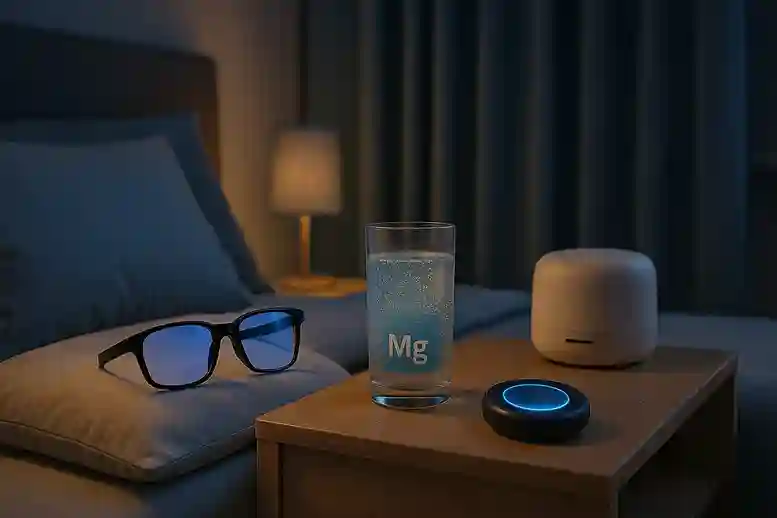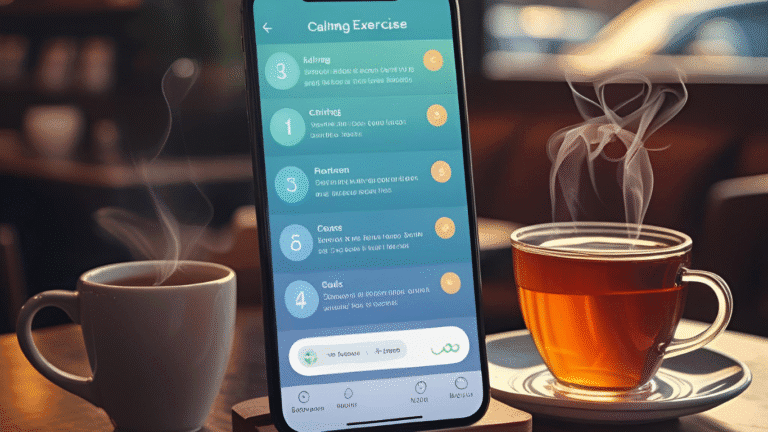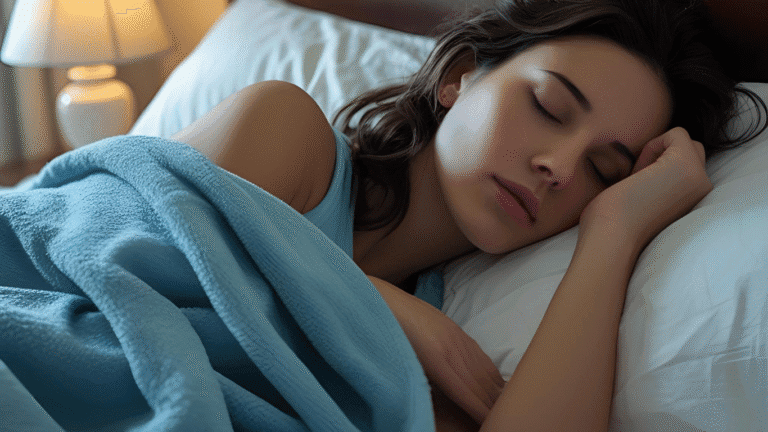What Is Sleepmaxxing and Why It’s Everywhere
Sleepmaxxing is a viral sleep trend taking over TikTok and wellness spaces across the USA in 2025. Promising the perfect sleep routine, it combines science-backed habits with eye-catching, aesthetic hacks designed to help users maximize every minute of their rest. From blackout curtains and blue light blockers to magnesium mocktails and mouth taping, Sleepmaxxing aims to transform ordinary sleep into an optimized, high-performance ritual.
This blog will define what Sleepmaxxing really is, unpack the details behind this fast-growing trend, and help you separate fact from fiction. By understanding what works and what might be just hype, you can decide if Sleepmaxxing is a routine worth trying or simply a viral fad.
The Rise of Sleepmaxxing: How It Went Viral
Sleepmaxxing exploded in popularity thanks to viral TikTok videos showcasing elaborate, envy-inducing bedtime rituals. Influencers light candles, sip magnesium mocktails, tape their mouths, and tuck into beds layered with cooling sheets—all while promoting sleep as a curated experience.
This trend ties closely to the broader self-optimization and biohacking movement. Just like productivity tracking or gut-health routines, Sleepmaxxing treats rest as something to measure, refine, and perfect. For many, it’s no longer enough to get 8 hours of sleep—it has to be “clean,” efficient, and algorithmically approved.
Gen Z and millennials have especially embraced Sleepmaxxing. Raised on apps and fueled by burnout culture, they’re drawn to routines that promise better energy, skin, and focus—all through optimized sleep. And the numbers back it up: in early 2025, videos tagged #sleep, #sleephacks, and #sleepmaxxing racked up over 2 billion views across major platforms.
What Sleepmaxxing Includes: Habits, Tools, and Rituals
Sleepmaxxing routines aim to optimize every element of rest—from how your bedroom looks to what you drink before bed. It’s more than just getting to sleep; it’s about crafting the perfect environment and behavior for maximum recovery.
1. Blue-Light Blocking Glasses
One of the simplest and most science-supported habits in Sleepmaxxing is wearing blue-light blocking glasses after sunset. Blue light emitted by smartphones, computers, and LED lights suppresses melatonin—the hormone responsible for regulating sleep-wake cycles. By reducing this exposure in the evening, these glasses help signal to your brain that it’s time to wind down.
Wearing these glasses for at least an hour before bed is common among Sleepmaxxers. The goal is to preserve natural melatonin production and ease the transition into sleep.
2. Magnesium Mocktails or Supplements
Magnesium is often called the “relaxation mineral” because it helps calm the nervous system and relax muscles. Sleepmaxxing enthusiasts frequently incorporate magnesium supplements or “mocktails” — beverages mixed with magnesium powder, herbal teas, or calming ingredients — into their bedtime routine.
The idea is that this gentle supplementation helps reduce restlessness and anxiety, paving the way for smoother sleep onset. While magnesium can support relaxation, experts recommend consulting a healthcare professional before starting supplements.
3. Mouth Taping
Mouth taping is one of the more controversial Sleepmaxxing habits. It involves placing a small piece of medical tape over the lips to encourage nasal breathing during sleep. Advocates claim nasal breathing improves oxygenation, reduces snoring, and leads to deeper, more restorative sleep.
However, this practice isn’t medically advised for everyone and may carry risks, especially for those with breathing disorders like sleep apnea. Medical consultation is important before trying this habit.
4. Blackout Curtains and Cold Rooms
Environmental control is a cornerstone of Sleepmaxxing habits. To create the ideal sleep environment, many optimize their bedrooms with blackout curtains to eliminate all light sources and maintain total darkness. Darkness stimulates melatonin production, signaling the body that it’s time to sleep.
Additionally, Sleepmaxxing emphasizes a cool room temperature—around 65°F (18°C). Cooler environments support the natural drop in core body temperature needed to fall asleep and maintain deep sleep stages.
5. Sleep Trackers and White Noise Apps
Tech is integral to many Sleepmaxxing routines. Sleep trackers—worn on wrists or placed under pillows—monitor sleep cycles, providing feedback on duration and quality. Many users adjust their habits based on this data, aiming to “hack” their sleep for maximum benefit.
Complementing this, white noise apps or machines create consistent, soothing background sounds that mask disruptive noises. This helps maintain uninterrupted sleep, especially in noisy environments.
Why These Habits Matter
Together, these habits reflect Sleepmaxxing’s goal: to control every variable that affects rest. The idea is to not just fall asleep, but to optimize sleep depth, timing, and quality through a carefully curated routine.
However, while some habits are backed by strong science, others are more experimental or carry potential risks. Understanding the difference is key to making Sleepmaxxing work for you without causing stress or harm.
What Science Says About Sleepmaxxing
Sleepmaxxing blends proven sleep hygiene habits with newer, trend-driven practices. Understanding which parts are supported by research—and which raise concerns—is essential to using this trend wisely.
Backed by Evidence
Consistent Sleep Schedule:
Scientific studies show that going to bed and waking up at the same time every day strengthens your body’s internal clock. This leads to better sleep quality, easier falling asleep, and improved daytime energy.
Reducing Blue Light Exposure:
Exposure to blue light in the evening suppresses melatonin, the hormone that signals your body to prepare for sleep. Wearing blue-light blocking glasses or limiting screen time before bed helps maintain natural melatonin levels and improves sleep onset.
Cool, Dark Environments:
A dark room promotes melatonin production. Similarly, cooler temperatures (around 65°F or 18°C) align with the body’s natural drop in core temperature during sleep, helping you fall asleep faster and stay in deep sleep longer.
Relaxation Before Bed:
Engaging in calming activities—like reading, gentle stretching, or meditation—helps reduce stress hormones that interfere with falling asleep. Creating a wind-down routine is a foundational sleep hygiene strategy.
Questionable or Risky Sleepmaxxing Practices
Mouth Taping Without Medical Advice:
While some claim mouth taping encourages nasal breathing and better sleep, there is limited clinical evidence to support this. It may pose risks for individuals with sleep apnea, nasal congestion, or other breathing issues.
Overuse of Supplements:
Magnesium and other supplements can aid relaxation, but excessive or inappropriate use might cause side effects. Supplements are not a replacement for healthy habits and should be used cautiously.
Anxiety Around “Perfect” Sleep — Orthosomnia :
Obsessing over sleep quality, often fueled by tracking apps and strict routines, can paradoxically worsen sleep. Orthosomnia is a recognized condition where anxiety about sleep leads to insomnia and fatigue.
Bottom Line
Sleepmaxxing contains many habits firmly rooted in science. However, some trendy elements lack strong evidence or could even cause harm if misused. Balancing enthusiasm for Sleepmaxxing with critical evaluation and expert guidance will help you benefit from this trend without unnecessary risks.
Sleepmaxxing vs. Basic Sleep Hygiene: A Side-by-Side Comparison
| Feature | Sleep Hygiene | Sleepmaxxing |
|---|---|---|
| Definition | Simple, evidence-based sleep habits | Curated routines aimed at optimizing every detail of sleep |
| Approach | Practical, flexible | Structured, often aesthetic and intense |
| Examples | Regular bedtime, screen limits, dark room | Blue-light glasses, mocktails, mouth taping, sleep tech |
| Cost | Low to none | Often involves supplements, gadgets, or specialty tools |
| Accessibility | Easy for most people to adopt | May be time-consuming or expensive |
| Scientific Support | Strong backing from sleep research | Mixed—some habits are proven, others are trendy or untested |
| Goal | Improve natural sleep quality | Maximize rest efficiency and control every sleep factor |
| Risk Level | Very low | Varies—some elements may cause stress or health concerns |
| Sustainability | Highly sustainable long-term | May become overwhelming or anxiety-inducing |
| Keyword Insight | — | Sleepmaxxing builds on basic sleep hygiene but may go too far |
The Mental Health Trap: When Sleepmaxxing Backfires
Sleepmaxxing promises deeper rest, sharper mornings, and full-body optimization. But for some, it does the opposite—breeding stress, perfectionism, and even disordered sleep.
Orthosomnia: The Anxiety of “Perfect Sleep”
One growing concern is orthosomnia, a term coined by sleep researchers to describe anxiety caused by trying too hard to sleep “right.” People obsessed with optimizing every detail—sleep stages, breathing patterns, bedtime rituals—often report worse sleep, not better. Why? Because fixating on performance increases nighttime stress, which ironically disrupts rest.
Tracking apps and wearables, a core part of many Sleepmaxxing routines, can fuel this spiral. Instead of listening to the body, users may rely on data that misrepresents how rested they actually feel.
When Rest Becomes a Performance
Sleep is supposed to be a passive, restorative process. But Sleepmaxxing can turn it into a nightly checklist of “have-to-dos”: magnesium mocktail? Check. Mouth tape? Check. Deep sleep goal met? Maybe.
This mindset encourages people to treat sleep like a competition—one they must win by out-hacking their own biology. The result? Increased cortisol, delayed sleep onset, and worsening insomnia in some users.
What Experts Say: Know When to Let Go
Many sleep doctors agree: a consistent routine and stress reduction matter more than tracking everything. If you find yourself dreading bedtime or worrying over your sleep score, it may be time to unplug.
“When you’re anxious about sleep, you’re already losing rest,” says one clinical psychologist. “Sometimes, the healthiest move is to ditch the gadgets, skip the ritual, and simply go to bed.”
Bottom line: Sleepmaxxing may help some—but for others, chasing the perfect sleep becomes the reason they can’t sleep at all.
Should You Try Sleepmaxxing? A Balanced Take
Sleepmaxxing can offer real benefits—but it’s not for everyone. Understanding who might gain from this trend—and who should be cautious—is key to making a smart choice.
Who Might Benefit?
People struggling to establish a consistent sleep routine often find Sleepmaxxing’s structure helpful. If you:
- Have an irregular schedule
- Need motivation to develop bedtime habits
- Want to experiment with proven sleep aids like blackout curtains or blue-light blocking glasses
Sleepmaxxing’s step-by-step, ritualized approach can provide the guidance and accountability needed to improve sleep quality.
Who Should Be Cautious?
If you tend toward anxiety, perfectionism, or already suffer from insomnia, Sleepmaxxing might do more harm than good. While it promises better rest through structure and control, it can easily become a source of stress. People with anxiety often fixate on whether they’ve followed every part of the routine correctly—worrying about screen exposure, the timing of supplements, or whether their sleep tracker will show improvement.
For perfectionists, the aesthetic and performance-based aspect of Sleepmaxxing can create pressure to “do sleep right,” making rest feel like yet another achievement to unlock. And for those with insomnia, too much focus on sleep data can lead to orthosomnia—a condition where obsessing over sleep quality actually prevents you from sleeping well. In these cases, the pursuit of perfect rest may backfire, reinforcing the very sleep problems it’s meant to solve.
For these groups, over-optimization risks creating pressure instead of relief.
Recommended Approach
The best advice is to begin with basic sleep hygiene: maintain a consistent sleep and wake time, reduce screen exposure at least an hour before bed, and create a cool, dark, and quiet environment. These foundational habits are backed by strong scientific evidence and help regulate your body’s natural rhythms. If you’re curious about Sleepmaxxing, introduce its habits slowly—perhaps starting with blackout curtains or magnesium supplements. Pay close attention to how your body and mind respond. If a practice feels stressful or disrupts your rest, it’s okay to stop. Sleep should feel restorative, not like a performance. Balance is key.
Avoid turning sleep into a performance. Remember, quality rest comes from simplicity, not complexity.
Checklist: What’s Worth Trying
| Category | Habit/Tool | Notes |
|---|---|---|
| ✅ Worth Trying | Consistent sleep & wake times | Supports your body’s natural rhythm |
| Dimming lights before bed | Helps melatonin production | |
| Avoid screens or use blue light filters | Reduces sleep-disrupting blue light exposure | |
| Cool, dark, quiet environment | Ideal for deep, uninterrupted sleep | |
| White noise or calming sounds | Masks disruptive noises | |
| Natural wind-down aids (e.g., magnesium mocktails) | May support relaxation; use moderately | |
| Relaxation rituals (reading, meditation, breathwork) | Helps reduce stress before sleep | |
| ⚠️ Try With Caution | Mouth taping | Consult a doctor before trying |
| Over-the-counter sleep supplements | Possible side effects; avoid long-term use | |
| Sleep trackers | Use for trends only; avoid obsessing | |
| ❌ Probably Skip | Constantly changing routines | Disrupts sleep consistency |
| Hyper-analyzing sleep data | Can increase anxiety and worsen sleep | |
| Making sleep routines “perfect” for social media | Adds unnecessary pressure and distraction |
FAQ : What You Really Need to Know
Conclusion
Sleepmaxxing blends proven wellness practices with aesthetic rituals—and it’s catching fire online for a reason. From blackout curtains to magnesium mocktails, the trend encourages better sleep awareness. But let’s not forget: basic sleep hygiene still does the heavy lifting.
No supplement, gadget, or TikTok tip can replace a consistent bedtime, a dark and quiet room, and a calm mind.
💬 Have you tried Sleepmaxxing or even a small part of it? Share your honest experience below—what worked, what didn’t?

Alexia Greene is a health blogger dedicated to making wellness simple, practical, and accessible for everyone. With a strong background in nutrition and healthy living, she writes about balanced diets, fitness tips, and mindful habits that support long-term well-being. Alexia’s mission is to empower readers with trustworthy information and actionable steps they can use in their everyday lives.
When she’s not writing, Alexia enjoys cooking wholesome meals, practicing yoga, and exploring new ways to live a healthier lifestyle. Her approachable style and evidence-based advice make her a trusted voice in the world of health and wellness blogging.


